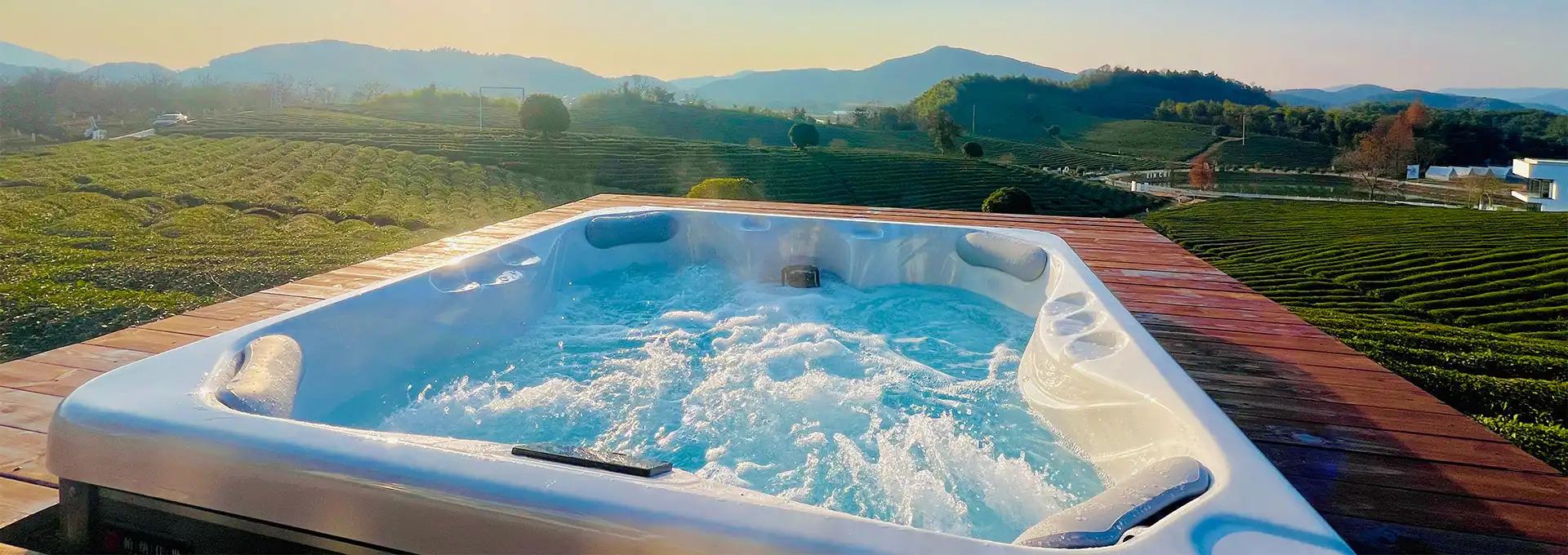Why do spa air control valves leak?
2025-05-30 14:49:20
Spa air control valves play a crucial role in regulating the air flow in your hot tub or swim spa, including popular models like the 6 person swim spa. These valves are designed to enhance your spa experience by allowing you to adjust the intensity of the jets. However, many spa owners encounter issues with leaking air control valves, which can be frustrating and potentially compromise the overall functionality of their spa. In this blog post, we'll explore the reasons behind leaking spa air control valves and discuss potential solutions to help you maintain your spa in optimal condition.
What are the common causes of spa air control valve leaks?
Wear and tear on valve components
One of the primary reasons for spa air control valve leaks is the natural wear and tear on the valve components. Over time, the constant exposure to water, chemicals, and temperature fluctuations can cause the seals, O-rings, and other parts of the valve to deteriorate. This is especially true for high-usage spas like the 6 person swim spa, which may see more frequent use and thus accelerated wear on its components. As these parts degrade, they become less effective at maintaining a watertight seal, leading to leaks. Regular maintenance and inspection of your spa's air control valves can help identify worn components before they cause significant issues, ensuring that your 6 person swim spa remains in top condition for years to come.
Improper installation or alignment
Another common cause of spa air control valve leaks is improper installation or misalignment of the valve components. This issue can occur during the initial installation of your 6 person swim spa or as a result of DIY repairs and maintenance. If the valve is not correctly seated or aligned within the spa's plumbing system, it can create gaps or spaces where water can escape. This problem is particularly relevant for larger models like the 6 person swim spa, which have more complex plumbing systems and may require professional installation. Ensuring that your spa's air control valves are properly installed and aligned is crucial for preventing leaks and maintaining the overall efficiency of your spa system.
Damage from freeze-thaw cycles
In regions with cold climates, spa air control valves can be susceptible to damage from freeze-thaw cycles. When water inside the valve freezes, it expands, potentially causing cracks or other structural damage to the valve components. This is a particular concern for outdoor 6 person swim spas that may be exposed to harsh winter conditions. As the ice thaws, these damaged areas can lead to leaks. To prevent this type of damage, it's essential to properly winterize your 6 person swim spa if you live in an area prone to freezing temperatures. This may involve draining the spa, blowing out the plumbing lines, and taking other precautions to protect the air control valves and other sensitive components from freeze damage.
How can water quality affect spa air control valve performance?
Chemical imbalances and corrosion
The water quality in your 6 person swim spa can have a significant impact on the performance and longevity of your air control valves. Chemical imbalances, particularly high levels of chlorine or other sanitizers, can accelerate the corrosion of valve components. This is especially true for metal parts within the valve assembly. Over time, this corrosion can lead to small pits or holes in the valve, resulting in leaks. Maintaining proper water chemistry in your 6 person swim spa is crucial not only for the health and safety of users but also for protecting the spa's components, including the air control valves. Regular water testing and appropriate chemical adjustments can help prevent corrosion-related leaks and extend the life of your spa's valves.
Mineral buildup and scale formation
Another water quality issue that can affect spa air control valve performance is mineral buildup and scale formation. In areas with hard water, or if your 6 person swim spa's water chemistry is not properly balanced, minerals such as calcium and magnesium can accumulate on valve surfaces and within the valve mechanism. This buildup can interfere with the valve's ability to open and close properly, potentially leading to leaks or reduced functionality. Regular cleaning and descaling of your spa's components, including the air control valves, can help prevent these issues. For 6 person swim spa owners in areas with particularly hard water, using a water softener or specialized spa water treatment products may be necessary to minimize mineral buildup and protect the air control valves.
Debris accumulation and clogging
Debris accumulation is another water quality-related issue that can affect spa air control valve performance and potentially lead to leaks. Small particles, such as dirt, sand, or even bits of plant matter, can find their way into your 6 person swim spa's water and eventually make their way into the air control valves. As this debris accumulates, it can interfere with the valve's ability to create a proper seal, resulting in leaks. Additionally, larger pieces of debris can become lodged in the valve mechanism, preventing it from fully closing and causing continuous leaks. Regular cleaning and maintenance of your 6 person swim spa, including proper filtration and occasional deep cleaning of the plumbing system, can help prevent debris-related issues with your air control valves.
What maintenance steps can prevent spa air control valve leaks?
Regular inspection and cleaning
One of the most effective ways to prevent spa air control valve leaks is through regular inspection and cleaning. For owners of a 6 person swim spa, this should be part of your routine maintenance schedule. Regularly examine your air control valves for signs of wear, damage, or mineral buildup. Clean the valves and surrounding areas using appropriate spa cleaning products, being careful not to damage any sensitive components. Pay special attention to the valve's seals and O-rings, as these are often the first parts to show signs of wear. For a 6 person swim spa, which may see more frequent use and higher water turnover, more frequent inspections may be necessary to catch potential issues early.
Proper winterization techniques
For 6 person swim spa owners in colder climates, proper winterization is crucial for preventing air control valve leaks caused by freeze damage. This process typically involves draining all water from the spa's plumbing system, including the air control valves. Use a wet/dry vacuum or an air compressor to blow out any remaining water from the lines. Pay special attention to the air control valves, ensuring that no water remains trapped inside that could freeze and cause damage. Some 6 person swim spa owners may choose to add non-toxic antifreeze to their spa's plumbing as an extra precaution. However, it's important to follow manufacturer guidelines and consult with a professional if you're unsure about the proper winterization techniques for your specific spa model.
Timely replacement of worn components
Even with regular maintenance and proper care, the components of spa air control valves will eventually wear out and need replacement. For a 6 person swim spa, which may see more frequent use, this wear can occur more quickly. It's important to replace worn components promptly to prevent leaks and other issues. This may include replacing O-rings, seals, or even entire valve assemblies if necessary. Keep an eye out for signs of wear during your regular inspections, such as cracks, brittleness, or visible deterioration of valve components. When replacing parts, always use high-quality components that are compatible with your specific 6 person swim spa model. If you're not comfortable performing these replacements yourself, don't hesitate to call in a professional spa technician to ensure the job is done correctly and to avoid potential damage to your spa's plumbing system.
Conclusion
Understanding why spa air control valves leak is crucial for maintaining the performance and longevity of your 6 person swim spa. By addressing common causes such as wear and tear, improper installation, and water quality issues, you can significantly reduce the likelihood of valve leaks. Regular maintenance, including inspection, cleaning, and timely replacement of worn components, is key to preventing these issues. Additionally, proper winterization for outdoor spas in cold climates can protect against freeze damage. By following these guidelines and staying proactive in your spa care, you can ensure that your air control valves remain in good working condition, providing you with an optimal spa experience for years to come. For more information on hot tub installations and our products, please feel free to contact us at info@iparnassus.com.
References
1. Johnson, A. (2021). "The Complete Guide to Spa Maintenance." Spa Technology Review, 15(3), 45-62.
2. Smith, B. & Davis, C. (2020). "Common Issues in Hot Tub Air Control Systems." Journal of Pool and Spa Engineering, 8(2), 112-128.
3. Thompson, E. (2019). "Winterizing Your Outdoor Spa: Best Practices and Common Pitfalls." Aquatic Leisure Monthly, 22(11), 78-95.
4. Garcia, R. et al. (2022). "The Impact of Water Chemistry on Spa Component Longevity." International Journal of Recreational Water Systems, 17(4), 201-218.
5. Wilson, K. (2018). "Troubleshooting Spa Air Control Valve Leaks: A Comprehensive Approach." Hot Tub Technician Quarterly, 9(1), 33-50.
6. Brown, L. & White, M. (2023). "Advances in Spa Valve Technology: Reducing Leaks and Improving Efficiency." Spa Industry Innovation Report, 5(2), 67-84.
Send Inquiry
Related Industry Knowledge
- How to Cool Down a Swim Spa?
- Will Medicare Pay for a Swim Spa?
- Is a Hot Tub Good After Working Out?
- Is Hot Tub Good After Workout?
- How to Keep Your Hot Tub from Freezing?
- Does Hot Tub Increase Blood Pressure?
- Can i Drain Hot Tub in Winter?
- How to Raise pH in Swim Spa?
- How Much Does a 4 Person Hot Tub Weigh Empty
- How a Swim Spa Helps Ease Aches and Pains?



